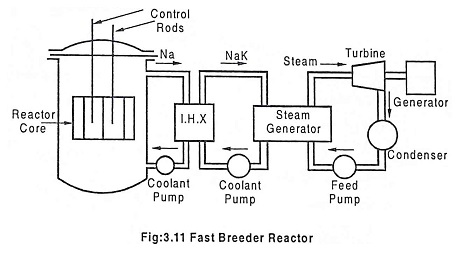Fast Breeder Reactor (FBR) – Definition and Working Principle:
Breeding – The process of producing fissionable material from a fertile material such as Uranium 238 (U238) and thorium 232 (Th232) by neutron absorption is known as breeding. The fast breeder reactor system is shown in Fig. 3.11.
Pu239 and U233 are fissionable materials and can be used in chain reaction.
In this Fast Breeder Reactor (FBR) system, the core containing U235 is surrounded by a blanket of ferrite material U238. In this reactor, no moderator is used. The fast moving neutrons liberated due to fission of U235 are absorbed by U238 which gets converted fissionable material Pu239 which is capable of sustaining chain reaction. Thus, the reactor is very important because it breeds fissionable materials from fertile material U238 available in large quantities.
This reactor system uses two liquid metal coolant circuits. Liquid sodium is used as primary coolant when circulated through the tubes of Intermediate Heat Exchanger (IHX) and transfers its heat to secondary coolant sodium potassium alloy. The secondary coolant transfers its heat to feed water while flowing through the tubes of steam generator.
Considering safety and thermal efficiency, fast breeder reactors are better than conventional reactors.
The following coolants are commonly used for fast breeder reactors.
- Liquid metal (Na (or) NaK)
- Helium (He)
- Carbon dioxide.
Sodium has the following advantages.
- Sodium has very low absorption cross-sectional area.
- Sodium possesses good heat transfer properties at high temperature and low pressure.
- Sodium does not react any of the structural materials used in primary circuits.

